Bronco versatility includes 2-door, stick shift
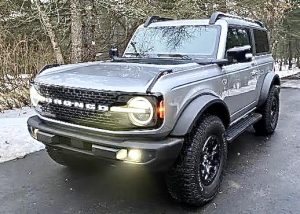
Larger than the Bronco Sport, the “regular” Bronco is roomier, more rugged, and has a 2-door version.
By John Gilbert
Auto companies can baffle us with the manipulation of introductions, and the most recent example is the highly popular Ford Bronco, which revives the name of the company’s original SUV workhorse, loaded up with modern technology. If I didn’t know better, I might have thought Ford created more questions than it answered when it brought out a string of the versatile and useful Bronco, although I enjoyed all the different versions I drove.
How could you not enjoy the Bronco Sport, a tight little 4-door SUV capable of handling all your objectives for family SUV duties or light off-roading? And then I got a second one, also a Bronco Sport, and also fun to operate. And later still, I got one with a stick shift that was a bit more work/off-road oriented, with a slick-shifting 7-speed manual. After all that, I got the bigger Bronco, not the Bronco Sport, and in 2-door fashion.
I knew that Ford also was bringing out a larger Bronco a bit later than the Bronco Sport, with more interior room, and the ability to haul more people and stuff. So about the time I figured out the 4-door Bronco, I got a couple different 2-door models, and they also were fun to drive, and felt sportier.
If you aren’t slightly confused by now, maybe you haven’t been paying close attention. I eagerly hopped into the most recent Bronco, realizing immediately something was different. That was because it was a 2-door, after all the earlier ones of both were 4-doors.
The 4-door is well made and takes care of business efficiently. But, c’mon — don’t we all harbor secret fantasies about having a 2-door SUV? I know I have.
The first 2-door model I had was the stick shift! Ford has equipped some Broncos with a 7-speed stick, and that gives you the ability to keep it right where you want it no matter what your intentions are. Fortunately, the second one I got came equipped with the 10-speed automatic, a smooth-shifting unit that is perfectly set up for the equipment at hand and offered a comparison.
The Bronco 2-door Advanced 4X4 was the “Black Diamond” model and felt light and quick, and came with a 2.3-liter EcoBoost twin turbocharged 4-cylinder engine. The stick was remarkably smooth to shift and accelerated out of trouble with ease. It has 275 horsepower and 315 foot-pounds of torque.
The hill-start assist is a neat feature, with a stick, because it puts you at ease when you stop on a hill, sure that the vehicle won’t start rolling backward while you’re heel-and-toeing at a stoplight short of the crest.
That’s particularly handy if you’ve gotten a little rusty in your heel-and-toe skills with a stick and a clutch. It also had what Ford calls “full vehicle steel bash plates.”
The 2-door gives you a spacious rear seat, although getting into it requires some agility.
The Black Diamond trim is neat and gives you some dded features, including an optional removable roof. Ford wants the Bronco to tackle the same off-road projects as the Jeep Wrangler, so it starts out by making it available with doors that pop off, in addition to the roof, so you can go cavorting around doorless and topless, if that suits you. Also in the concept of stripping it down for hardy use, the side mirrors come affixed to the frame itself, rather than on the door, which always seems to cause more vibration and need for adjustment. No adjustment needed, in this case, even if the doors are back home in the garage.
The Bronco 2-door with the 10-speed automatic was equipped with the Wildtrak package, which means, in my tester’s case, a 2.7-liter EcoBoost V6, with lots of excessive power, compared to the 2.3-liter 4. The V6 lists 315 horsepower and 410 foot-pounds of torque, at a sticker price of $53,650.
Curiously, the larger engine with the automatic didn’t feel as quick as the four with the stick.
One of the features that attracts folks to the Bronco is the array of gadgets that make it seem like a good deal, such as the cargo area protectors, the black roof rails, and the neat LED headlights that shine in a tight pattern even though appeareing to be squinting just a bit. The heavy duty floormats can be hosed off for cleaning if your off-roading includes acquiring a bit of mud inside and out.
When I first saw the array of Broncos, I wasn’t sure where I stood. But the stick-shift 2.3-liter version lists for $42,720, as equipped, while the 2.7 V6 model lists for $53,650. Both have distinct personalities, after you realize there are some differences.
The smaller Bronco Sport, with four doors, makes any selection a tough choice. Among the impressive advancements in modern cars is that some of the new 4s perform right up there with the usual V6es, and some of the new automatics seem to work as efficiently as the best stick shifts. Such modern automatics work so smoothly that they can relegate the stick shifts to the discard pile. Unless, that is, you like stick shifts as much as I do.
In the case of the Bronco family, the stick can make the 4-cylinder feel quicker and deliver better fuel economy than the V6. In that manner, the stick makes the 4-cylinder function like old-time off-roaders, even ones originally called Broncos.
That is especially so if you take the doors off and let it all hang out, so to speak.


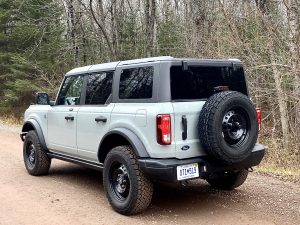
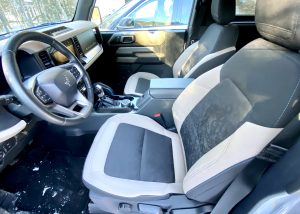
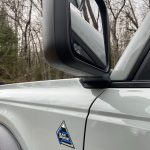
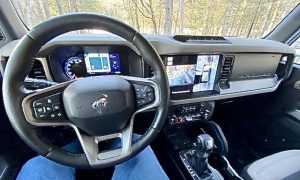
 John Gilbert is a lifetime Minnesotan and career journalist, specializing in cars and sports during and since spending 30 years at the Minneapolis Tribune, now the Star Tribune. More recently, he has continued translating the high-tech world of autos and sharing his passionate insights as a freelance writer/photographer/broadcaster. A member of the prestigious North American Car and Truck of the Year jury since 1993. John can be heard Monday-Friday from 9-11am on 610 KDAL(www.kdal610.com) on the "John Gilbert Show," and writes a column in the Duluth Reader.
John Gilbert is a lifetime Minnesotan and career journalist, specializing in cars and sports during and since spending 30 years at the Minneapolis Tribune, now the Star Tribune. More recently, he has continued translating the high-tech world of autos and sharing his passionate insights as a freelance writer/photographer/broadcaster. A member of the prestigious North American Car and Truck of the Year jury since 1993. John can be heard Monday-Friday from 9-11am on 610 KDAL(www.kdal610.com) on the "John Gilbert Show," and writes a column in the Duluth Reader.